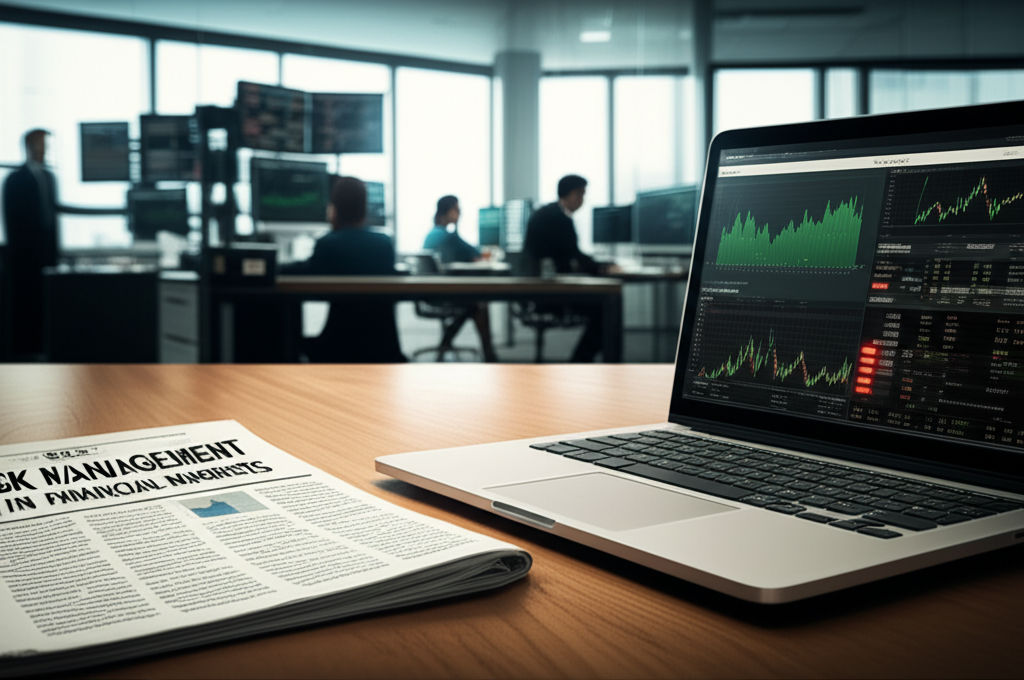Risk Management: Protect Your Business
Emily Willis

Photo: Risk Management: Protect Your Business
In today's dynamic business landscape, navigating uncertainties is not merely a challenge but a fundamental aspect of sustainable growth. Every organization, regardless of its size or industry, faces a myriad of potential threats that can impact its operations, financial stability, and reputation. This is where risk management steps in, acting as a crucial shield to protect your business and ensure its long-term resilience.
Understanding and proactively addressing these potential pitfalls is no longer optional; it's a strategic imperative. By embracing a robust risk management strategy, businesses can not only minimize losses but also identify opportunities, make informed decisions, and build a foundation for sustained success. This article will delve into the core principles of risk management, guiding you through actionable steps to safeguard your enterprise in an ever-evolving world.
What is Risk Management and Why Does Your Business Need It?
At its heart, risk management is a systematic process of identifying, assessing, and controlling potential threats or uncertainties that could affect an organization's ability to achieve its objectives. It's about anticipating what could go wrong and having a plan in place to either prevent it, reduce its impact, or respond effectively if it occurs.
Think of it this way: just as you wouldn't embark on a long journey without checking your vehicle or planning your route, a business shouldn't operate without understanding and preparing for its potential challenges. The world does not always respond as expected, and unforeseen events, from economic shifts to natural disasters, can significantly impact a business.
The benefits of effective risk management are far-reaching and critical for any business aiming for stability and growth:
- Protects Assets and Financial Health: By identifying potential financial risks like cash flow issues or market volatility, businesses can implement measures to safeguard their capital and earnings.
- Enhances Decision-Making: A structured risk management framework provides valuable data and insights, enabling leaders to make more informed and confident decisions.
- Minimizes Losses: Proactive risk mitigation helps prevent costly mistakes, legal penalties, and financial setbacks that can arise from unexpected incidents.
- Improves Operational Efficiency: By systematically identifying and addressing vulnerabilities, businesses can streamline processes and ensure smoother operations, even during disruptions.
- Maintains Compliance and Reputation: Effective risk management ensures adherence to regulations and industry standards, protecting a business's legal standing and public image. A damaged reputation can lead to significant financial and shareholder value losses, as seen in cases like Chipotle's E-Coli outbreaks.
- Fosters Innovation and Growth: By understanding and managing risks, businesses can confidently pursue new opportunities and adapt to market changes without being paralyzed by fear of the unknown.
Ultimately, risk management is not just a compliance exercise; it's an ongoing process that builds resilience and positions your business for long-term success.
Identifying Potential Threats: The First Step to Business Protection
The cornerstone of any effective risk management plan is the ability to thoroughly identify potential threats. You can't protect what you don't recognize. This involves looking both internally at your operations and externally at the broader environment.
Common Categories of Business Risks
Businesses face a diverse array of risks, which can generally be categorized to help with identification:
- Financial Risks: These relate to a company's monetary stability and can include issues like cash flow problems, market volatility, credit risks, interest rate fluctuations, or unexpected increases in costs. For instance, a small business heavily reliant on a single large client faces significant financial risk if that client defaults on payment.
- Operational Risks: These stem from the day-to-day activities and processes of a business. Examples include supply chain disruptions, equipment failures, human error, product defects, or inefficient internal processes.
- Strategic Risks: These arise from poor business decisions or changes in the competitive landscape. This could involve an ineffective marketing campaign, a poorly timed expansion, or failing to adapt to evolving customer demand or new technologies.
- Cybersecurity Risks: In the digital age, these are paramount. They encompass threats like data breaches, ransomware attacks, phishing scams, and system failures, which can lead to significant financial and reputational damage. Statista estimates cybercrime losses could reach $15.63 trillion by 2029.
- Compliance and Legal Risks: Businesses must adhere to a complex web of laws, regulations, and industry standards. Non-compliance can lead to hefty fines, lawsuits, and a damaged reputation. This includes data privacy laws, employment laws, and industry-specific regulations.
- Reputational Risks: Negative publicity, poor customer service, ethical lapses, or product recalls can severely damage a business's image and public trust, impacting sales and long-term viability.
- Human Resource Risks: These involve issues related to employees, such as high turnover, lack of skilled staff, workplace accidents, employee fraud, or insufficient training.
- External and Environmental Risks: These are often beyond a business's direct control, including natural disasters (fires, floods, earthquakes), economic downturns, political instability, or pandemics.
How to Conduct a Risk Assessment
Identifying these risks requires a systematic approach. A risk assessment is the process of pinpointing vulnerabilities and evaluating their potential impact and likelihood.
Here are practical steps to conduct a thorough risk assessment:
- Brainstorming and Workshops: Gather key stakeholders from different departments (finance, operations, IT, HR) to brainstorm potential risks. Encourage open discussion about what could go wrong.
- Review Historical Data: Look at past incidents, near-misses, audit reports, customer feedback, and employee incident reports. What problems have occurred before? What lessons can be learned?
- Conduct a SWOT Analysis: This strategic planning tool helps identify internal Strengths and Weaknesses, and external Opportunities and Threats. Threats are your risks, and weaknesses can highlight internal vulnerabilities.
- Consult with Employees and Customers: Those on the front lines often have valuable insights into operational risks and customer satisfaction issues.
- Analyze Business Processes: Break down your operations into individual processes and identify potential failure points at each step.
- Prioritize Risks: Once identified, assess each risk based on its likelihood (how probable is it?) and impact (how severe would the consequences be?). A simple matrix (low, medium, high for both) can help prioritize. Focus on high-impact, high-likelihood risks first.
Strategies for Effective Risk Mitigation: Building Your Business Shield
Once risks are identified and assessed, the next crucial step is to develop risk mitigation strategies. This involves implementing measures to reduce the likelihood of a risk occurring or lessening its impact if it does. There are four primary approaches to risk mitigation:
1. Risk Avoidance
This strategy involves eliminating the risk entirely by choosing not to engage in the activity that carries the risk.
- Example: A business might avoid expanding into a politically unstable region to circumvent geopolitical risks, or decide not to offer a new product if the regulatory compliance burden is too high and complex.
2. Risk Reduction (or Control)
This is the most common approach and focuses on implementing controls to minimize the likelihood or impact of a risk.
- Implement Robust Security Measures: For cybersecurity risks, this means using strong firewalls, encryption, regular software updates, and multi-factor authentication.
- Diversify Suppliers: To mitigate supply chain risks, avoid relying on a single supplier. Having multiple sources for critical components can prevent major disruptions.
- Employee Training: Train employees on safety protocols, cybersecurity best practices, and emergency procedures. Human error is a significant risk factor.
- Quality Assurance Programs: For product or service delivery, implementing rigorous quality checks can reduce the risk of defects and customer dissatisfaction.
- Contingency Planning: Develop detailed plans for how your business will continue operations during or after a disruptive event (e.g., a power outage, natural disaster, or cyberattack). This is often part of a broader business continuity plan.
3. Risk Transfer
This strategy involves shifting the financial consequences of a potential risk to a third party.
- Insurance: The most common form of risk transfer. Businesses purchase various types of insurance (e.g., general liability, property, cyber liability, business interruption) to cover potential losses.
- Outsourcing: Transferring certain functions (like IT support or payroll) to specialized third-party providers can transfer some associated operational and compliance risks.
Latest ✨
View AllExplore diverse startup funding options beyond VCs & bank loans. This guide covers bootstrapping, equity, debt, & more to fuel your business growth.
Emily Willis
Economic Stimulus: Do they work? Unpack government's toolkit, from fiscal to monetary policy, and understand their true impact on your economy.
Emily Willis
Explore economic blocs: powerful alliances shaping global trade, fostering cooperation & competition. Understand their types & impact on your world.
Emily Willis
Explore critical trends shaping the future of business, with AI driving efficiency, innovation, and growth. Adapt now for success beyond 2025.
Emily Willis
Business
View All
August 4, 2024
The Importance of Financial Management for Small and Medium Enterprises (SMEs)emphasizes the importance of effective financial management for small and medium enterprises (SMEs) in a competitive business environment.
Emily Willis

August 5, 2024
Financial Planning Strategies for a Healthy Businessfinancial planning for the success of any business. It discusses key strategies such as creating a budget, managing cash flow, forecasting, managing debt, maximizing profitability, risk management, and utilizing technology.
Emily Willis

June 8, 2025
Plan Your Business Exit StrategyPlan your business exit strategy: a roadmap to a successful future. Maximize value, protect your legacy, and ensure a smooth transition.
Emily Willis
Economy
View AllNavigate financial markets confidently! This guide demystifies risk management, helping you protect investments, enhance stability, and secure your financial fu...
Read MoreThe stock market is a crucial component of the global economy, providing a platform for capital formation, investment, and wealth creation. Understanding stock market movements, including bull and bear markets, market volatility, and factors influencing stock prices, is essential for investors, businesses, and policymakers. Economic, financial, and behavioral factors all play a role in shaping stock market dynamics.
Read MoreUncover the bond market's true nature. Is it a safe haven? Learn its benefits, inherent risks, and how to confidently integrate bonds into your portfolio.
Read MoreEntertainment
View All
August 5, 2024
Music's Evolving Landscape: Technology, Social Media, and Global TrendsThe music industry has undergone significant changes due to technological advancements, social media, and a growing global audience. The shift from analog to digital formats, the rise of streaming services, and the impact of social media on artist-fan relationships are explored.
Emily Willis

August 5, 2024
Classic Films: Timeless Masterpieces in the Age of StreamingClassic films may seem outdated in today's world of instant gratification and endless streaming options, but they offer enduring stories, masterful storytelling, historical insights, technical innovation, and artistic value that surpass modern offerings. While classic films face challenges such as accessibility and pacing, there are ways to overcome these obstacles, such as using streaming services, visiting local libraries, attending film festivals, and utilizing online resources.
Emily Willis

August 5, 2024
Video Games: Enduring Appeal, Immersive Worlds, and Diverse Genresenduring appeal of video games, highlighting their ability to transport players to fantastical realms, challenge their minds, and foster connections with others. It explores the magic of immersive worlds, the vast array of genres available, and the social power of gaming.
Emily Willis
Health
View Allpreventive health measures in promoting longevity and enhancing quality of life. It discusses essential strategies such as maintaining a balanced diet, regular physical activity, adequate sleep, stress management, regular health screenings, immunizations, avoiding harmful substances, and prioritizing mental health.
Emily Willis
Regular exercise is essential for maintaining both physical and mental health. It helps with weight management, cardiovascular health, muscle strength, energy levels, and sleep quality. Exercise also reduces stress and anxiety, improves mood, cognitive function, and self-esteem, and lowers the risk of depression. Different types of exercises, such as aerobic, strength training, flexibility, balance, and mind-body exercises, contribute to overall health. To start and maintain an exercise routine, it is important to start slowly, set realistic goals, find enjoyable activities, stay consistent, and listen to your body.
Emily Willis
Quality sleep is essential for overall health and well-being, impacting physical, cognitive and emotional functioning. Lack of quality sleep can lead to a variety of health issues, including weakened immune function, heart problems, weight gain and cognitive impairment.
Emily Willis
Trending 🔥
View All
1
2
3
4
6
7
8
9
10
Sports
View AllAugust 5, 2024
Sportsmanship in the Spotlight: Cultivating Respect, Integrity, and Ethical Behavior
Read MoreTechnology
View All
August 4, 2024
Bridging the Digital Divide: Ensuring Everyone Has Access to Technology
we can bridge this gap and create a more inclusive digital landscape.

August 4, 2024
The Metaverse: A Virtual World with Endless Possibilities
metaverse is a rapidly evolving concept that offers a network of interconnected 3D virtual spaces accessed through technologies like VR and AR.

August 4, 2024
All-Time High Cybersecurity Breach: How to Safeguard Your Company and Personal Information
threat of cybersecurity breaches in today's digital age, highlighting factors contributing to the rise in cyberattacks such as increased reliance on technology, evolving threats, remote work, and profit motive for cybercriminals.

August 5, 2024
Oculus Quest 2 vs HTC Vive Pro – Which Should You Choose?
Oculus Quest 2 vs HTC Vive Pro – which VR headset reigns supreme? Dive into this ultimate showdown to discover the strengths and weaknesses of each, and decide which one is worth your investment. From specs and comfort to content and price, we'll help you make an informed choice.





















